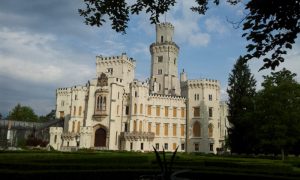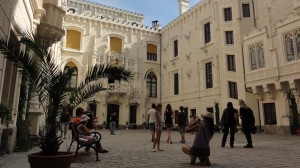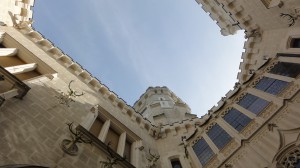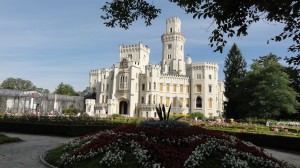Hluboká nad Vltavou Chateau
By Tracy A. Burns
Jumping out of a fairy tale
 Hluboká nad Vltavou Chateau looks as if it has leaped out of a fairy tale in its glistening white Neo-Gothic style, inspired by Romantic Windsor chateaus in England and imbued with an elegance that charms as well as enthralls. There are two tours, one of the representative rooms and another of the private apartments with kitchens.
Hluboká nad Vltavou Chateau looks as if it has leaped out of a fairy tale in its glistening white Neo-Gothic style, inspired by Romantic Windsor chateaus in England and imbued with an elegance that charms as well as enthralls. There are two tours, one of the representative rooms and another of the private apartments with kitchens.
From the 13th to the 17th century
It is hard to believe that this south Bohemian treasure began as a 13th-century military fortification. At the end of the 13th century, it was the castle of Czech king Přemysl Otakar II. By the 15th century, though, the former royal residence was in ruins. In 1534 owner Ondřej Ungnad of Sunek came to the rescue, rebuilding it and adding vineyards and a mill. Then it was Jáchym of Hradec’s turn. He transformed the medieval jewel into a Renaissance masterpiece in 1562, reconstructing it with three storeys and three inner courtyards. He also constructed an exquisitely painted chapel. However, tragedy struck. Jáchym drowned while returning from Christmas celebrations in Vienna, Austria. After Jáchym’s death, his son Adam II carried on where his father had left off, working with Italian artists.
Tremendous and terrible times
 By 1600 Hluboká had blossomed into a bewitching chateau with a vineyard, gardens, a brewery, a mill, a game reserve, and more. Challenging times were to come, though, as the chateau was plundered twice in the 17th century. Finally, in 1661, Johann Adolf I of Schwarzenberg rebuilt it in Baroque style. Johann Adolf II of Schwarzenberg was responsible for giving the chateau a Romantic-style makeover based on English residences. His wife, Eleonora, Princess of Liechtenstein, decorated the representative rooms. They kept the chateau in the family until World War II, when, in 1940, the Nazis confiscated it. In 1945 Hluboká became state property.
By 1600 Hluboká had blossomed into a bewitching chateau with a vineyard, gardens, a brewery, a mill, a game reserve, and more. Challenging times were to come, though, as the chateau was plundered twice in the 17th century. Finally, in 1661, Johann Adolf I of Schwarzenberg rebuilt it in Baroque style. Johann Adolf II of Schwarzenberg was responsible for giving the chateau a Romantic-style makeover based on English residences. His wife, Eleonora, Princess of Liechtenstein, decorated the representative rooms. They kept the chateau in the family until World War II, when, in 1940, the Nazis confiscated it. In 1945 Hluboká became state property.
Tapestries, woodwork, and weapons
Perhaps most stunning in the chateau is its collection – the largest in Bohemia – of rare Flemish tapestries, 57 in total. Eight of them, stemming from the 17th century, illustrate proverbs while others show an Oriental theme of Buddhist symbols designating eternity and wisdom. The exquisite and elaborate rich woodwork and wood paneling are also highlights of the chateau. The visitor is confronted with such woodwork near the entrance: The main stairway overwhelms with wooden designs, and the nearby tea room is a woodcarver’s dream. The richly decorative wooden paneling around a nonfunctional fireplace is another example. The elaborately carved wooden mirror frame in the Reading Room was created by five woodcarvers over a 17-month time period. A Rococo sleigh features exquisite wooden carvings made from linden wood. The armory is also worth a visit, ranking as one of the largest of its kind in central Europe and boasting weapons from the 13th to the 19th century. A magnificent knight’s saddle as well as Turkish and Persian weapons plus various cannons are among its treasures.
The library
On the tour of the representative rooms, the library is a masterpiece not to be missed. With two geographic and astronomical globes, huge portraits, and some 12,500 books, the dignified space flaunts Classicist shelves, a Baroque fireplace, and stained glass panels. The 16th-century wooden table is the oldest piece of furniture in the chateau.
Other representative rooms
One bedroom features a canopy bed with Rococo elements and a wooden ceiling with golden and floral décor. An intarsia cabinet is also on display. There are two hidden doors in the Changing Room, where a 17th-century tapestry of Aeneas and Dido dominates the space as the ruins of Troy and the Trojan horse play roles in the picture. Gilded leather wallpaper adorns the ceiling. A cabinet features Baroque-style dolphins that look like dragons. Four golden chandeliers dominate the Morning Salon while historic styles of furniture with textiles showing flowers and countryside scenes make appearances in the Schwarzenberg Gallery. Notice the rich woodwork on the doors. The Smoking Room includes gilded leather wallpaper – red with gold and black décor – on the walls and a 720-ton white, marble fireplace. One of the women’s cabinets is decorated with a 19th-century portrait of Holy Roman Emperor Rudolf II.
More objects of interest
 Venetian chandeliers with pink and green adornment plus blue and white Delft faience plates created during the 17th and 18th centuries seem to magically appear in other spaces. One object of interest is a painted desk adorned with the picture of the Virgin Mary and flowers, dating from the early 18th century and hailing from Venice.
Venetian chandeliers with pink and green adornment plus blue and white Delft faience plates created during the 17th and 18th centuries seem to magically appear in other spaces. One object of interest is a painted desk adorned with the picture of the Virgin Mary and flowers, dating from the early 18th century and hailing from Venice.
The Hunting Dining Room and Living Room
Highlights of the tour of the private apartments include the Hunting Dining Room, the Living Room, and the kitchens. The wooden chairs in the Hunting Dining Room are exquisitely carved, and the Neo-Renaissance Nuremberg-type chandeliers boast antlers as well as figures and coat-of-arms. An ivory clock features the number four as Roman numeral IIII rather than IV. The Living Room is surrounded by three walls with breathtaking, green tapestries sporting the Schwarzenberg coat-of-arms. A tea set from Turkey and a brown tiled stove are other decorations.
The kitchens
The big or hot kitchen, the cold kitchen, and the sweet kitchen make impressive appearances as well. The equipment hails from the latter part of the 18th century, and the large stoves and large tanks for heating water were created at the beginning of the 20th century. The sweet kitchen features a special stove with ovens stacked onto each other. The temperature could be selected according to the kind of pastry. As many as 60 chickens could be roasted at the same time using an open fire with skewers that turned thanks to hot air. A knife-cleaning machine is another intriguing piece. The knives are inserted into slots, and when the handle is turned, flaps of felt and leather polish the cutlery.
Technological advancements
The chateau also consists of early 20th-century technological advancements. A hydraulic elevator from 1906 that was converted into an electric one during the 1930s and box-like telephones from 1931 also adorn the chateau. Made by ATOM, the big and bulky vacuum cleaner without wheels looks like a red robot and hails from the beginning of the 20th century. By turning the handle, leather bags compress, inducing negative pressure.
A tourist’s treasure
 Hluboká nad Vltavou is not only one of the jewels of south Bohemia but of the entire Czech Republic. Tapestries, weapons, ornate furnishings, technological advancements, and impressive kitchens are just a few reasons why tourists in the Czech lands should make this lavish and charming chateau a top priority.
Hluboká nad Vltavou is not only one of the jewels of south Bohemia but of the entire Czech Republic. Tapestries, weapons, ornate furnishings, technological advancements, and impressive kitchens are just a few reasons why tourists in the Czech lands should make this lavish and charming chateau a top priority.
Hluboká nad Vltavou Chateau – Winter Tour
In the past, the chateau has been closed to the public from October 31 to April 1 of the following year. The chateau is welcoming visitors during the off-season. Visitors see the bigger section of the ground floor, which comprises the former private apartments of the last four generations of the chateau owners. First, the Hamilton Salon will impress visitors. In the hallway, tourists will gaze at framed photographs of the members of the Schwarzenberg dynasty as well as hunting trophies and hunting-themed drawings from the 18th century. The motif of hunting is present in other rooms, too, such as the Smoking Salon and Teresa Small Dining Room. We also see the opulent, hunting-themed Dining Room, the area where meals were prepared, and the Small Dining Room of Dr. Adolf as well as his study, living room, and bedroom.


